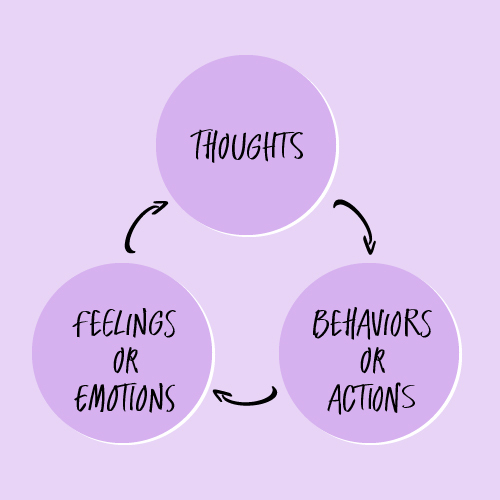The good news? Learning to identify and reframing those negative thought patterns is proven to measurably improve anxious or depressive feelings. Think of this as strengthening your psychological immune system. Negative thoughts won’t be able to “infect” your emotional state or mental health if you practice recognizing them and taking their power away. The goal is to work to understand these feelings with a greater sense of calm and distance by talking to yourself differently.
For example, if you have a busy day ahead and you find yourself thinking “This is going to be so stressful,” take a moment to observe that thought, understand where it comes from and consider alternative narratives about the day ahead. Instead you might say to yourself, “I have been here before, this level of stress is something I can manage, and I can use the tools that I have to help me manage it.” This kind of self-talk can neutralize a negative thought and prevent it from controlling your emotions.
CBT Lesson
Cleaning Up Your Thinking
Why This Works
As you’ve probably noticed, your thoughts have a tremendous impact on your emotions and actions. For example, when you’re having a bad day at work or anxiously tending to a hundred tasks at home, your anxious thoughts impact your stress levels and the way you go about your day.
Very often, a thought is the initial trigger that escalates your emotions. That thought can turn into many constant, racing thoughts. This is called rumination. You might be constantly fearful or constantly blaming yourself for something. (Does that sound familiar?) And this all makes it difficult to focus.
Know this: Having negative thoughts is completely normal! But sometimes, those thoughts and the emotions they stir up can become patterns or loops that crowd out positive emotions, and you can feel stuck. Getting stuck in negative thought patterns can make it more likely that you’ll experience depressive or anxious symptoms.

Learn a Skill:
Reframing Thoughts

Practice
Here’s an exercise that will strengthen your mental immune system by helping you notice and identify the negative thoughts that hurt your mental health, so you can eventually avoid them safely.
1. List any thoughts you notice that are associated with your depressive or anxious feelings. Notice how those thoughts might be increasing your stress. Are they helping calm your mind or are they fueling your distress?
2. Reframe each thought: Replace the stressful thought with one that’s more reasonable and calming. Consider telling yourself a calmer story. If you can begin to say to yourself, “I can handle this, I'll be okay,” and “This is uncomfortable, but I’m ok,” you’ll be able to develop greater calm and control in response to stress and anxiety.

Next Step:
Find a Provider
Engaging with a therapist can significantly improve your treatment results as studies suggest patients who take medication see better outcomes if therapy is part of the treatment plan. Websites which may be helpful in finding a local therapist are Psychology Today: Health, Help, Happiness + Find a Therapist and the Psychologist Locator from the American Psychological Association, to find a psychologist in your area.
You can also try internet based self help cognitive behavioral therapy. Nurx has a great list of therapy resources available.

Please note: Nurx does not provide therapy or counseling. Nurx is not available for crisis response. If you are experiencing a mental health crisis, please contact 911 or go to your nearest emergency department. IF YOU ARE CONTEMPLATING SUICIDE, CONTACT 911 OR THE NATIONAL SUICIDE PREVENTION LINE AT 1-800-273-TALK (8255).
Take Control Today
Nurx also offers prescription medication for anxiety and depression. Connect with a medical provider online, from anywhere, for a personalized treatment plan, medication delivered, if medically appropriate, and ongoing support on your schedule.

Exceptional care at every step
At Nurx, we make it easy to get the expert healthcare you deserve. From schedules to health history, everybody is different—so we provide treatment and care that’s personalized to you. Through life’s cycles, changes, and transitions, we’re here to help you make informed choices about your health.


